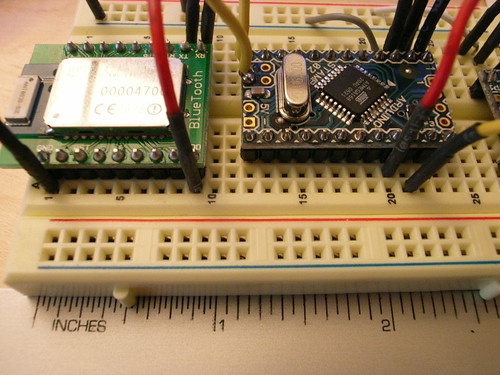Without too much ado, I’ve been seeing how it goes designing in a Bluetooth module with the Arduino Mini. It’s not difficult at all, really. The thing that gives me a belly-ache is how relatively expensive Bluetooth modules are, generally. This one here set me back around $60USD, single units. It doesn’t get much cheaper ($50USD for bare surface-mount modules, small quantities, ~$40USD 100 units.)
Here you just do the normal cross over drill, connecting RXD on the Arduino Mini to TXD on the Bluetooth module; TXD on the Arduino Mini to RXD on the Bluetooth module.
I’m using this Bluetooth module, which is just this one with a DIP mounting.
Some design issues are power consumption — the radio in these modules can get hungry, although the particular unit I’m using can be adjusted in the firmware. Also, the 2.4GHz radio signal kind of spills all over the place, which can cause a problem for designs that use magneto-sensing, such as a compassing application.
I am thinking about designing this with a low-power Atmel (ATmega16L or ATmega32L). One reasons is to simplify integration with TWI/I2C and SPI low-power sensors (most of the one’s I use operate in the 1.8-3.6v CMOS range), and to generally lower power consumption. Downside is the processors run slower (~4MHz), but I can scarcely think of any application I’ve developed or even am thinking about where I need tons of speed.
The main reason for exploring this is to find ways to integrate a mobile phone into Arduino-based applications such as, for instance, a graphical interface for games, etc.
Massimo Banzi, et. al., have been busy getting the Bluetooth Arduino ready for delivery!
